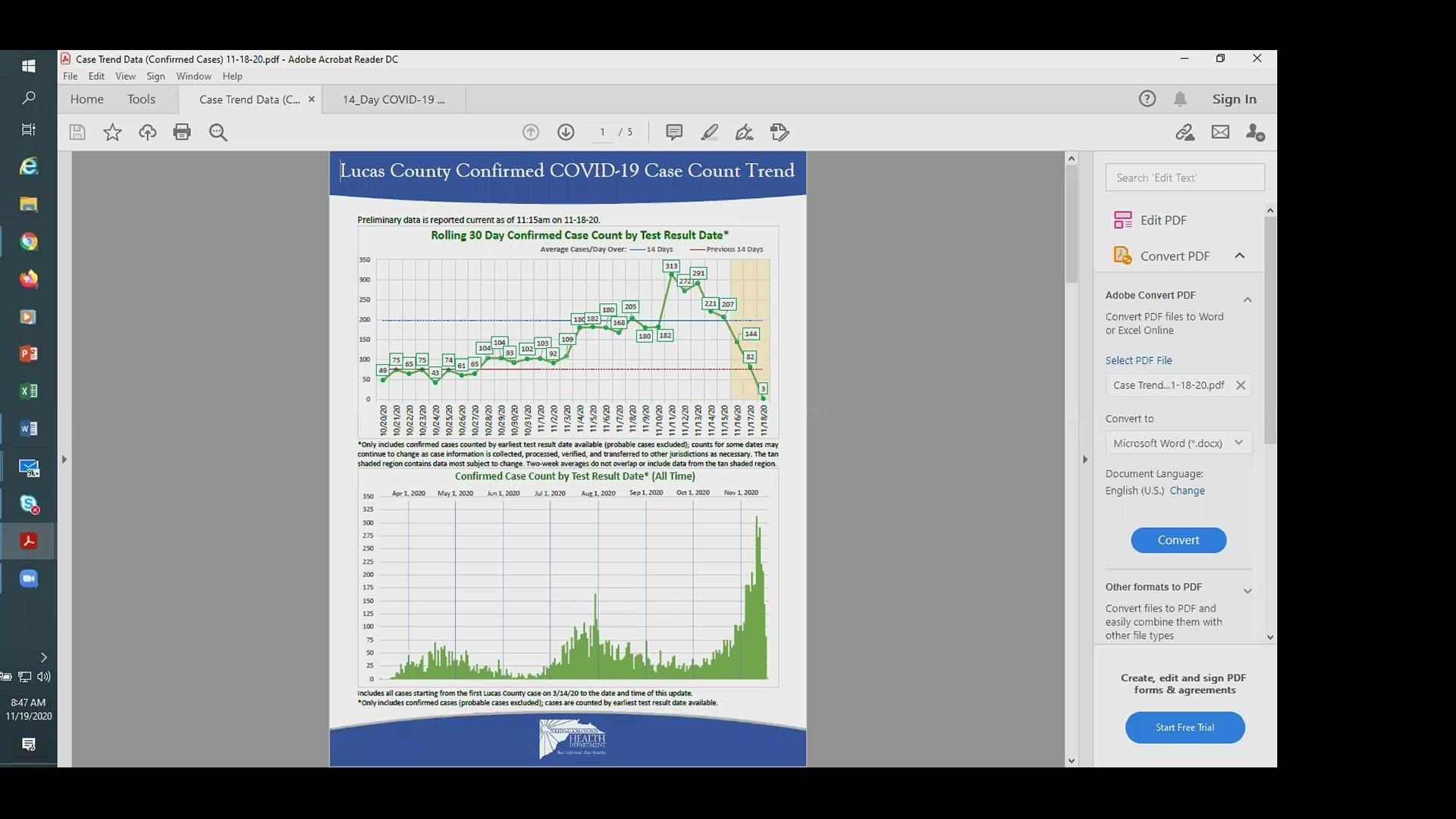LUCAS COUNTY, Ohio — The Toledo-Lucas County Board of Health issued a stay-at-home advisory Thursday, going into effect immediately and lasting until Dec. 17.
“Gathering together is extremely risky right now. It is more risky than it was a month-and-a-half ago. It’s more risky than it was two weeks ago,” Lucas County Health Commissioner Eric Zgodzinski said.
STAY-AT-HOME ADVISORY
Starting immediately, residents are advised to:
- Leave home only for work/school or essential needs such as medical care, grocery/pharmacy, picking up food, receiving deliveries.
- Continue to wear a mask and stay 6 feet from others and wash your hands.
- Avoid unnecessary travel both in and out of the state of Ohio.
- Have no guests in your homes except for essential workers.
- Cancel large traditional holiday celebrations if at all possible. Do not add guests to your meals who live outside of your home.
- If you choose to have a holiday meal with guests outside of those who live in your home, wear masks, stay 6 feet apart, use separate serving utensils and cups.
- Stay home if you've had exposure to a COVID-19 positive person.
- Limit meetings/social events to a maximum of 10 individuals, both for indoor and outdoor events.
- If you exhibit COVID-19 like symptoms, shelter in place and do not go to work or any congregate setting.
This is a "living document" and could see changes coming to it, the health board said.
Zgodzinski explained that residents can still go out and do physical things, like going for a run, jog or hike as long as distancing is maintained or you stay within your "bubble" of those living in your household. He used an example, saying playing basketball with those you lived with on Thanksgiving is OK, but it would be smart to avoid that pick-up game.
Lucas County's positivity rate is now around 15% or more, the commissioner said. The county is also seeing high incidence of spread, with more than five times the Centers for Disease Control and Prevention threshold of 100 cases per 100,000 people.
The goal of the advisory is to get people to understand and rethink their behaviors in their everyday life. Coupled with the curfew, trying to say to the residents, if you don’t need to go out – don’t go out.
Board members made clear that stricter guidance may need to be implemented in the future should the situation not improve, and the need could be revisited in the next week.
Hospitals continue to inch toward critical levels, Dr. Richard Monk said, saying they are getting closer and closer to hitting the "straw that broke the camel's back."
“If we start seeing flu with COVID, and all the things we see on a daily basis, our hospitals will not be able to handle those things,” Zgodzinski said.
He explained that in some areas, emergency vehicles have already run into situations where they have had to reroute to facilities that were further away.
Zgodzinski suggested that a second advisory, or something more, will be discussed regarding county schools in the near future.
OTHER STAY-AT-HOME ADVISORIES IN THE STATE
Franklin and Cuyahoga counties both announced stay-at-home advisories today, with Cuyahoga County's effective immediately and Franklin County's effective beginning Nov. 20. These advisories are independent of the statewide curfew.
The stay-at-home advisory in Cuyahoga County asks all residents to stay home and avoid heading out for unnecessary trips. The advisory includes the recommendation that schools and churches also close their doors to stop the spread of the virus.
Those who live within Cuyahoga County are strongly advised to not host guests in their home over the next 28 days as well, and also avoid traveling outside of the state.
In Franklin County, people are asked to only leave home if they have to go to work, school or for essential needs, such as going to the pharmacy, receiving medical care, picking up food or getting groceries.
The Franklin County advisory will remain in place for two consecutive incubation periods of the coronavirus, or 28 days, or until health officials in that area determine a change in the advisory is needed.
OHIO CURFEW
In an effort to slow the spread of COVID-19, Ohio Gov. Mike DeWine implemented a 21-day curfew beginning this Thursday, Nov. 19.
The curfew will be in effect from 10 p.m.- 5 a.m. over a three-week span.
It's aimed at keeping Ohioans home during the restricted hours in an effort to limit contacts. Although targeted at individuals, retail locations and some businesses would be expected to close during the curfew.
Restaurants and bars must also stop serving in-person customers at 10 p.m. during the curfew period. Takeout, however, can remain open beyond 10 p.m.
The curfew does NOT include the following:
- People going to or from work.
- Those who have an emergency.
- Those who need medical care.
- Grocery shopping.
- Going to the pharmacy.
- Picking up carryout or a drive-thru meal. Delivery is also permitted.
- Yes, you can still take your dog outside or go for a walk.
“We’re not asking police to go pull anybody over," Gov. DeWine said Wednesday. "If you’re in your car, no one should be bothered being in their car. The other example would be if you’re at a gas station at 10:30 at night and there’s four or five people hanging around, I would think the police would stop and say, ‘Hey, go home. Get out of here. Go home.’ We know the police have a lot to do. I believe that most Ohioans are going to follow this and will go home, be home. We know there’s going to be emergencies. People have babies, things happen. Those people should be able to do what they need to do.”

